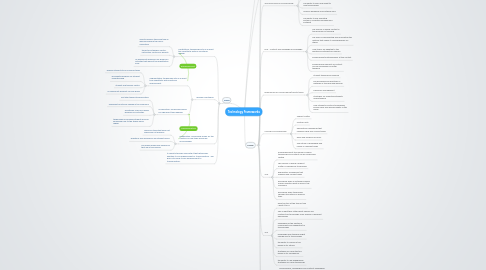
1. SAMR
1.1. Substitution: technology acts as a direct tool substitute; with no functional change
1.1.1. used to preform the same task as was done before the use of computers.
1.1.2. tends to be teacher-centric: instruction controls all aspects
1.1.3. no significant difference on grades on activities that were at the substitution level.
1.2. Reuben Puentedura
1.2.1. Augmentation: technology acts as a direct took substitute: with functional improvement
1.2.1.1. enables students to do common tasks
1.2.1.2. immediate feedback for student understanding
1.2.1.3. student and teacher centric
1.2.1.4. no significant different on final grade
1.2.2. Modification: Technology allows for significant task redesign
1.2.2.1. first step toward transformation
1.2.2.2. significant functional change in the classroom
1.2.2.3. sometimes a half of a grade difference in activities
1.2.2.4. technology encourages student drive for knowledge due to the stakes being higher.
1.3. Redefinition: Technology allows for the creation of new tasks previously inconceivable.
1.3.1. allows for tasks that were not previously not possible
1.3.2. questions and discussions are student driven
1.3.3. one whole grade level difference that are in this domain.
1.4. It's what a teacher does with it that determines whether it is an enhancement vs. transformation. The goal is to move it from enhancement to transformation.
2. Philosophy for Teachnology
2.1. How technology can and should be used in your teaching. Ideally TPACK should inform your philosophy of Teachnology
2.2. Professional Growth Plan: Incorporate TK, PK and and CK.
3. 21st Century
3.1. Punya Mishra and Kristen Kereluik
3.1.1. Foundational Knowledge: 1)content, 2) information literacy, 3)cross-disciplinary knowledge
3.1.2. Meta Knowledge: 1) Problem Solving/Critical Thinking 2) communication.collaboration 3) creativity
3.1.3. Humanistic Knowledge: 1) life and job skills 2)cultural competence 3) ethical and emotional awareness
4. TPACK
4.1. 1986 - Lee Shulman identified that teachers have Content knowledge and Pedagogical knowledge. The domains overlap
4.2. 2006 - Punya Mishra and Matthrew Koehler added Technology Knowledge and TPACK was formed
4.2.1. WICKED PROBLEM
4.2.1.1. have incomplete, contridictory and changing problems
4.2.1.2. challenge to find consistent solutions to because they are in a constant state of change
4.3. TECHNOLOGICAL KNOWLEDGE
4.3.1. Knowledge and skills required to operate certain technologies
4.3.2. How to install and remove devices, software programs and documents
4.3.3. The ability to learn and adapt to new technologies
4.3.4. Specific hardware and software skills
4.3.5. The ability to use operating systems, computer hardware and software
4.4. PCK - Content and Pedagogical Knowledge
4.4.1. The manner in which content is transformed for teaching
4.4.2. The ways of representing and formulating the material that makes it comprehensible for others
4.4.3. How topics are adapted to the abilities and interests of learners
4.4.4. Knowing what methodologies fit the content
4.4.5. Knowing how elements of content can be rearranged for better teaching
4.5. PEDAGOGICAL KNOWLEDGE/How to teach
4.5.1. Student thinking and learning
4.5.2. The processes and practices or methods of teaching and learning
4.5.3. Classroom management
4.5.4. Strategies for evaluating students understanding
4.5.5. How Students construct knowledge, acquire skills and develop habits of the minds
4.6. CONTENT KNOWLEDGE:
4.6.1. Subject Matter
4.6.2. Central Facts
4.6.3. Explanatory frameworks that organize ideas and connect ideas
4.6.4. Rules and evidence of proof
4.6.5. The nature of knowledge and inquiry in different fields
4.7. TCK
4.7.1. Knowledge about the manner in which technology and content can be reciprocally related
4.7.2. The manner in which a subject matter is changed by technology
4.7.3. Explanatory frameworks that organize and connect ideas
4.7.4. Recognize when a software program merely emulates what is done in the classroom
4.7.5. Recognize when technology changes the nature of learning itself
4.8. TPK
4.8.1. Does the tool fit the type of task I want it to???
4.8.2. This is what they stated what affords and contraints of technology as an enabler of different approaches
4.8.3. Knowledge of the existence, components and capabilities of technologies
4.8.4. knowledge how teaching might change due to technologies
4.8.5. the ability to choose a tool based on its fitness
4.8.6. strategies for using the tool based on its affordances
4.8.7. the ability to use pedagogical strategies for using technology
4.9. TPCK
4.9.1. Technological, Pedagogical and Content Knowledge. Awareness of the complex interplay between PK TK and CK. is this activity well balanced? Does it lean toward on more than the other?
4.9.2. Pedagogical knowledge that uses technologies in constructive ways to teach content
4.9.3. Knowledge of how technology can be used to build upon existing knowledge
4.9.4. A thoughtful weaving of the interplay between TPCK
4.9.5. A nuanced understanding of the interplay between TPCK
4.9.6. Use of TPCK to develop appropriate, context-specific strategies and representations
